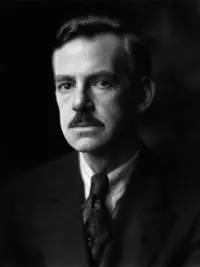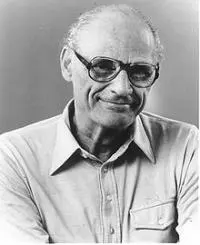Image by Michael Beckwith via Wikipedia Commons
Ever been to a really bad play? More specifically, have you seen a production of a play that, while clearly well-written, comes off either bland or way over-the-top in performance? This happens all the time, from high-school or university productions with little or no budget to Broadway spectacles of wealth. And for some of the greatest dramatic writers in history, this happens to their work more often than not.
Studying theater in college, numerous professors held the same opinion as to why this is the case: these authors wrote such dense and complex works that they are extremely difficult to get right onstage. I certainly agree with this viewpoint, but I'd like to go one step beyond and suggest that perhaps these heavy-duty plays work better as meaty reads rather than actual blueprints for a living, breathing, organic production.
This isn't so radical a notion. Writing for Francis Ford Coppola's Zoetrope Magazine, famed playwright Edward Albee argued that reading plays, as opposed to seeing them, was the optimal experience:
Most simply put: plays—the good ones, at any rate, the only ones that matter—are literature, and while they are accessible to most people through performance, they are complete experiences without it...
Succinctly, anyone who knows how to read a play can see and hear a performance of it exactly as the playwright saw and heard it as he wrote it down, without the "help" of actors and director...no performance can make a great play any better than it is, and most performances are inadequate either in that the minds at work are just not up to the task no matter how sincerely they try, or the stagers are aggressively interested in "interpretation" or "concept" with the result that our experience of the play, as an audience, is limited, is only partial...
Of course, your reading of a play is also an opinion, an interpretation, but there are fewer hands (and minds) in the way of your engagement with the author.
I don't entirely agree with Albee: many playwrights' works are better seen than read, particularly those who have enjoyed careers both in theater and film—Sam Shepherd, Neil LaBute, and Martin McDonagh, for example. But I do think Albee is correct in many ways. By no means should you stop seeing plays, because there are wonderful actors, designers and directors out there who can take your breath away. But start reading plays too, because even the most stunning production cannot outdo your own imagination.
Here are four playwrights whose written works offer narrative experiences far superior to their staged counterparts, and one playwright whose work is ultimately better experienced as a production, but who you should read anyway.
Obligatory spoiler warning here. There are spoilers. You are warned.
1. William Shakespeare
 I don’t think there’s another playwright’s work more prone to terrible productions than old Willy Shakes. Perversely, he’s one of the most produced playwrights in all of theater history, but particularly now since his plays are in the public domain.
I don’t think there’s another playwright’s work more prone to terrible productions than old Willy Shakes. Perversely, he’s one of the most produced playwrights in all of theater history, but particularly now since his plays are in the public domain.
There’s a reason, however, you typically see productions of Romeo and Juliet on the high school or community theater level. That particular play is Shakespeare’s easiest to digest, and it’s such a prevalent work, I wonder if we’re not born with awareness of its narrative. Boy and girl from warring families fall in love, parents disapprove, boy and girl act like irrational teenagers, try to stage suicides, end up offing themselves for real, and the parents are left to contemplate their own folly. Tragic love story, bada bing, bada boom!
Yet even R&J, for all its simplicities, features linguistic complexities that most modern theatrical practitioners and patrons miss. Still, it is the most accessible and dramatic of Shakespeare’s work, so let’s not talk about that one anymore. Let’s talk about the Bard’s second-most popular play, Hamlet.
If we could speak right out of the womb, we might launch into the famous “To be or not to be” soliloquy. Hamlet is just as much ingrained in culture as its angsty teen counterpart, and perhaps it is tackled just as often on stage. I would argue, however, that only the most seasoned of directors and actors pull it off remotely well, and only those audiences acutely attuned to listening can ever really experience the total meaning of this work.
For one, Hamlet is loaded with monologues, particularly in the beginning, when Shakespeare has to give the audience a ton of backstory. Two, there’s a bit of a language gap these days, and while listening to these monologues you can surely get the gist of the speaker’s information, but you would be better served to read (and most likely re-read) the passage for deeper meaning. Here’s one of the first monologues from Horatio, delivering a bit of exposition to the other characters and to us:
That can I,
At least, the whisper goes so. Our last king,
Whose image even but now appear’d to us,
Was, as you know, by Fortinbras of Norway,
Thereto prick’d on by a most emulate pride,
Dar’d to the combat; in which our valiant Hamlet–
For so this side of our known world esteem’d him–
Did slay this Fortinbras; who, by a seal’d compact,
Well ratified by law and heraldry,
Did forfeit, with his life, all those his lands
Which he stood seiz’d of, to the conqueror...
This goes on for awhile (in a good way).
Imagine listening to an actor deliver these lines. For one, the complexity of the language would certainly demand our utmost attention, which tasks the actor with carefully choosing his or her operative word-—the most important word in each line of dialogue—and enunciating with skill. If the actor is doing his or her part, and the audience is paying attention, we can understand the basic information of this dialogue. Here’s how SparkNotes’ No Fear Shakespeare interprets the text:
I can. Or at least I can describe the rumors. As you know, our late king, whom we just now saw as a ghost, was the great rival of Fortinbras, king of Norway. Fortinbras dared him to battle. In that fight, our courageous Hamlet (or at least that’s how we thought of him) killed old King Fortinbras, who—on the basis of a valid legal document—surrendered all his territories, along with his life, to his conqueror.
Now, looking at the texts in succession, I’m sure you see the difference. Shakespeare’s version looks like poetry. That’s because it is. I’m sure you studied his sonnets in junior high as a primer for reading and understanding poetry. His plays are no different.
Look at the placement of words ‘Hamlet,’ ‘him’ and ‘compact,' placed in succession at the end of their respective lines. Clearly, there is meaning here: the name of the prince, also the title of the play; the word him, defined as “often used in place of ‘he’ after the verb ‘to be’”—or, ‘not to be’?; and compact, or contract, a legally binding document. Long before Hamlet’s famous soliloquy appears, Shakespeare is already setting up notions of existence in our minds—Hamlet is a ‘him’ or a man in official terms, but what does it mean to be a man? What does it mean to exist?
Also, Hamlet, as the son of the deceased king, has not ascended the throne for legal reasons—specifically, his uncle Claudius’ marriage to the widowed Queen Gertrude, a union more of convenience and political posturing than love (also, it turns out, Claudius killed the king). This arrangement between uncle and mother drives most of Hamlet’s brooding and plotting.
Shakespeare is more or less telling us the plot of the play with these three words. Hearing an actor deliver this speech—if he or she is to emphasize these words—we might come to this same realization, but likely if this does occur it would be on a subconscious level, because we cannot see these three words spatially grouped on a page. Therefore, I believe reading Hamlet, as opposed to watching it, gives audiences a greater opportunity to understand Shakespeare’s subtext.
And this coming from a bit of exposition at the beginning of the play! There are loads of twisty, meaty wordplay moments throughout Hamlet—including, of course, the “To be or not to be” speech. If you’ve only ever seen Shakespeare performed, but never read him, there is a wealth of information to discover and enjoy. Or, if you’re the opposite—only read, never seen—seek out some taped performances or film adaptations, and compare. Which narrative experience holds more informational and subtextual satisfaction?
Get The Folger Shakespeare Library at Amazon
2. Eugene O'Neill
 If you’re not familiar with this guy, check him out. He’s considered one of the best American playwrights ever. He won a Nobel Prize, multiple Pulitzers, and is credited with bringing realism in the style of Chekhov, Ibsen, and Strindberg to the United States. He’s an interesting cat, to say the least.
If you’re not familiar with this guy, check him out. He’s considered one of the best American playwrights ever. He won a Nobel Prize, multiple Pulitzers, and is credited with bringing realism in the style of Chekhov, Ibsen, and Strindberg to the United States. He’s an interesting cat, to say the least.
However, if you’re in a particularly good mood, I wouldn’t recommend reading his plays, because man, are they depressing as hell. Aside from his lone comedy, Ah! Wilderness, O’Neill focused on what he knew: alcoholism, disintegrating families, overbearing fathers, and pervasive bitterness. Not exactly light reading. And talk about dense!
His final play, A Long Day’s Journey Into Night, published posthumously, represents the culmination of these writerly approaches. According to A Contour in Time, a biography by Travis Bogard, “Long Day’s Journey into Night (sic) was the play he had been trying to write from the outset of his career; its achievement was his raison d’être as an artist.”
Reading Long Day’s Journey, it’s clear O’Neill was exorcizing many of his demons. The play is autobiographical, detailing the morning, afternoon and evening before his own admittance into a sanatorium for tuberculosis treatment. The three male protagonists—James, James, Jr., and Edmund Tyrone—are all battling alcoholism, while the mother, Mary Tyrone, is addicted to morphine. Over the course of the sixteen hour timeframe, “the characters conceal, blame, resent, regret, accuse and deny in an escalating cycle of conflict with occasional desperate and sincere attempts at affection, encouragement and consolation" (summary courtesy of Wikipedia). The work was so personal, O’Neill ordered it locked away in a Random House safe, not to be published until 25 years after his death (his wife Carlotta managed to subvert that timeframe and released it three years later).
I doubt O’Neill ever intended to see this play performed on stage. Likely, that requested gap between his death and publication ensured no one would care all that much to produce the play when it finally came out of the vault. Moreover, Long Day’s Journey is, for all intents and purposes, a 176 page novel comprised primarily of stage directions, with dialogue and monologues coming in second and third, respectively. O’Neill meticulously paints the Tyrones' living room, employing details that are impossible to see on a stage:
At rear are two double doorways with portieres. The one at the right leads into a front parlor with the formally arranged, set appearance of a room rarely occupied. The other opens on a dark, windowless back parlor, never used except as a passage from living room to dining room. Against the wall between the doorways is a small bookcase, with a picture of Shakespeare above it, containing novels by Balzac, Zola, Stendhal, philosophical and sociological works by Schopenhauer, Nietzsche, Marx, Engels, Kropotkin, Max Stirner, plays by Ibsen, Shaw, Strindberg, poetry by Swinburne, Rossetti, Wilde, Ernest Dowson, Kipling, etc.
First, to merely see the “rarely occupied” room would not necessarily elicit that intellectual connection. You might look at that room and say, “They really keep a tidy house.” The fact the room is “rarely occupied” bears no significant weight on the story, except that this detail gives us a deeper understanding of who this people are.
Ditto for the books on the shelves: this tells us the family is comprised of philosophical intellectuals, or possibly people who desire the appearance of intelligence without the hassle of all that homework. Yet onstage, all we’ll see are books, not specific authors. We might come to the same conclusion—that these people are well-read, or at least they want to be—but our understanding of exactly the kind of (pseudo)intellectuals we’re dealing with is sorely lacking without the written text to guide us. Furthermore, O’Neill is subtly telling us much about his characters’ psychology by referencing those specific philosophers.
The above excerpt is the first paragraph of the novel, ahem, play. Scene setting moves into character descriptions, and the whole thing goes on for three pages before a single line of dialogue is spoken—pretty much exactly what a novelist might do—set up the world of the story, allowing the reader to immerse themselves with environment and character before the ball gets rolling.
In performance, Long Day’s Journey is three to three-and-a-half hours of talking, talking, TALKING! Like his scene descriptions, O’Neill micro-manages every detail about the way characters say certain lines. Here’s an example from early in the narrative:
EDMUND
Irritably.
Oh, Mama, forget it! Who cares? Jamie and I would be bored still. And about the Old Man, what’s the use of talking? You can’t change him.
MARY
Mechanically rebuking.
Don’t call our father the Old Man. You should have more respect.
Then dully.
I know it’s useless to talk. But sometimes I feel so lonely.
Her lips quiver and she keeps her head turned away.
EDMUND
Anyway, you’ve got to be fair, Mama. It may have been all his fault in the beginning, but you know that later on, even if he’d wanted to, we couldn’t have had people here—
He flounders guiltily.
I mean, you wouldn’t have wanted them.
MARY
Wincing--her lips quivering pitifully.
Don’t. I can’t bear having you remind me.
I learned in Playwriting 101 that line delivery notes are a big no-no: actors hate them because they restrict their own creative interpretation, directors hate them for much the same reason, and overall they weigh down the flow of your script. This is not to suggest that O’Neill is a hack for employing so many delivery notes, because the man isn’t writing a script. He’s writing a novel, and delving into the psychological/emotional responses of the characters while they engage with each other is par for the course in fiction writing. Not to mention, “flounders guiltily” is almost impossible to convey exactly. Actors can internalize this direction and externalize it to the best of their ability, but there’s no guarantee it will read as “guilt,” particularly if the actor is less skilled at his trade. The audience may or may not understand O’Neill’s intentions while watching the piece performed, and yet in a reading context, the intent is literally spelled out for you.
As I said before, Long Day’s Journey is mostly stage/line directions. You can see every detail while reading it, almost like a movie projected in your head. O’Neill guides your sensory experience from the first page to the last, wielding his authorial control without showing his hand too much.
Long Day’s Journey is categorically not a skeletal blueprint demanding flesh from directors, actors, and designers; it is a fully-realized, self-contained piece of fiction that actively resists creative interpretation. It’s not a script. It’s a novel.
Get Long Day's Journey Into Night at Bookshop or Amazon
3. Samuel Beckett
 Perhaps most famous for his 1953 existential ‘tragicomedy’ Waiting for Godot, Samuel Beckett is difficult to pull off on-stage mostly because his work is so surreal, bordering on the bizarre and grotesque. Considered one of the first postmodernists in theater and an influential figure in the Theatre of the Absurd, Beckett’s plays are heady and philosophical, with a de-emphasis on plot and action. Waiting for Godot is, quite literally, about two vagrants waiting for someone named Godot, and (spoiler!) they continue to wait until the climax. Godot never arrives, and the vagrants can’t remember who s/he is or why they’re waiting. Are these characters dead and in limbo? If we take the OT out of Godot, do we realize who it is they’re waiting for? Beckett isn’t exactly forthright with the answer.
Perhaps most famous for his 1953 existential ‘tragicomedy’ Waiting for Godot, Samuel Beckett is difficult to pull off on-stage mostly because his work is so surreal, bordering on the bizarre and grotesque. Considered one of the first postmodernists in theater and an influential figure in the Theatre of the Absurd, Beckett’s plays are heady and philosophical, with a de-emphasis on plot and action. Waiting for Godot is, quite literally, about two vagrants waiting for someone named Godot, and (spoiler!) they continue to wait until the climax. Godot never arrives, and the vagrants can’t remember who s/he is or why they’re waiting. Are these characters dead and in limbo? If we take the OT out of Godot, do we realize who it is they’re waiting for? Beckett isn’t exactly forthright with the answer.
This penchant for withholding information colored his career as a minimalist. Beckett actually began as a fiction writer, modeling his work after the novels of James Joyce. However, according to James Knowlson’s 1997 biography Damned to Fame: The Life of Samuel Beckett, the author had a revelation about his literary idol:
I realized that Joyce had gone as far as one could in the direction of knowing more, in control of one’s material. He was always adding to it; you only have to look at his proofs to see that. I realized that my own way was in impoverishment, in lack of knowledge and in taking away, in subtracting rather than in adding.
Beckett fictionalized this revelation in his 1958 one act play Krapp’s Last Tape, which details the mental and sometimes physical meanderings of an old man as he listens to voice recordings of his younger self and reflects on his own folly. Krapp’s own life-altering revelation is silenced when the titular character stops the “last tape” mid-sentence.
In performance, Krapp’s Last Tape is noted for its extreme static. Long moments float by in which Krapp simply stares into space. He delivers long, often nonsensical monologues into his tape recorder. He listens to these recordings and those from his youth. He performs repetitive tasks and speech. It’s a difficult role for any actor to pull off. First, this is a one-man show, and all the burden of entertainment rests on his shoulders; second, making something watchable out of this ostensibly boring material requires master-level acting chops (there’s an excellent filmed performance by John Hurt that every other actor should probably just copy). Patience and a willing ear are once again required of the audience to fully understand what is happening and, more importantly, why.
However, when reading the text of Krapp’s Last Tape, you have additional time to ponder what the character says and does throughout the course of the narrative. Beckett scripts out every movement Krapp makes, and when you couple these lengthy stage directions and Krapp’s alternating young/old voice, what you basically get is an avant garde short story with dual, intersecting narratives that pushes the boundaries of standard prose. Let’s take a look:
[KRAPP switches off, raises his head, stares blankly before him. His lips move in the syllables of “viduity.” No sound. He gets up, goes backstage into darkness, comes back with an enormous dictionary, lays it on table, sits down and looks up the word.]
KRAPP [reading from dictionary]. State—or condition of being—or remaining—a widow—or widower. [Looks up. Puzzled.] Being—or remaining?...[Pause. He peers again at dictionary. Reading.] “Deep weeds of viduity”...Also of an animal, especially a bird...the vidua or weaver-bird...Black plumage of male...[He looks up. With relish.] The vidua-bird!
[Pause. He closes dictionary, switches on, resumes listening posture.]
TAPE. —bench by the weir from where I could see her window. There I sat, in the biting wind, wishing she were gone. [Pause.] Hardly a soul, just a few regulars, nursemaids, infants, old men, dogs. I got to know them quite well—oh by appearance of course I mean!
Once a fiction writer, always a fiction writer, it would seem. Beckett’s influence can be seen on the likes of Italo Calvino, William S. Burroughs, and Thomas Pynchon, and it’s no wonder. While theatrical writers certainly followed in Beckett’s footsteps, I think the ultimate experience rests not in the theater, watching an actor or actors bring his words to life, but rather at home, with his text printed in a book. Here, every movement, every thought, every word can be scrutinized and absorbed; here, all that static and lack of movement is less likely to make you squirm.
Check out that John Hurt performance, then read Krapp’s Last Tape, and decide for yourself which experience is more enjoyable.
Get Krapp's Last Tape and Other Dramatic Pieces at Bookshop or Amazon
4. Arthur Miller
 Remember high school? I often try to forget it, not so much because I was a weirdo outcast, but mostly because I was fantastically bored there. However, there were some highlights during that twelve year prison sentence, mostly from my Advanced English courses. Freshmen year, we read several classic novels—A Tale of Two Cities, The Scarlet Letter, The Great Gatsby, just to name a few.
Remember high school? I often try to forget it, not so much because I was a weirdo outcast, but mostly because I was fantastically bored there. However, there were some highlights during that twelve year prison sentence, mostly from my Advanced English courses. Freshmen year, we read several classic novels—A Tale of Two Cities, The Scarlet Letter, The Great Gatsby, just to name a few.
Alongside these texts, we read some Greek and Roman dramas, a little Shakespeare, George Bernard Shaw’s Pygmalion, and Arthur Miller’s The Crucible. These were the only playwrights we were exposed to then. I’m sure in larger cities or private schools, the canon of great dramatic writers woven into the mandatory literature curriculum is much broader, but Miller’s works are a staple. The man is considered one of the greatest American writers—not merely playwright, or dramatist, or scriptwriter. The distinctions between the different mediums break down when we talk about Arthur Miller.
This is because, by and large, that distinction in a general sense was breaking down around the time Miller began his career in theater. Practitioners of the dramatic arts in the 1940s were heavily influenced by the theories and methods of Constantin Stanislavski, the godfather of “method acting,” whereby actors use psychological substitution to elicit real emotional responses and in general ‘live within’ the role: you are the character, the character is you. This meant actors and directors had to dig deep into the playwright’s words, searching for subtext and meaning and constantly asking, why? Absorbing themselves into the works of Ibsen, Chekhov and Strindberg, these actors and directors found a wealth of psychological and emotional depth to work with.
Furthermore, the literary respect lavished on writers like Beckettt set the stage for widespread script-reading, not only from those within theatrical circles, but outside of them as well. Miller certainly wrote his plays as texts for pure reading enjoyment as well as blueprints for theatrical productions. Perhaps his most famous work, Death of a Salesman, proves this eloquently. Like O’Neill, Miller’s stage directions are long and detailed; yet unlike O’Neill, Miller uses more poetic, evocative language that actively employs the reader’s imagination and interpretive skills. Here are the first lines of Death of a Salesman:
A melody is heard, played upon a flute. It is small and fine, telling of grass and trees and the horizon. The curtain rises.
That sounds exactly like the first lines of a novel, no? I feel it’s writing like this that prompted Edward Albee to argue that reading plays is the optimal experience. A director could read this passage and find a piece of music to play as the curtain rises, or else commission a flutist to compose and perform something original. But it will never be the same music you heard reading the play.
Miller uses these evocative descriptors throughout. He writes that the play’s protagonist Willy Loman is “dressed quietly.” Quietly! As in, conservatively? Unpretentiously? In drab, unnoticeable colors? There are so many variations, and every reader collectively could never imagine all of them. Writing a play this way not only provides excellent prose that lends itself to individual interpretation, it’s also a solid career move on Miller’s part. His subject matter—disillusionment with the American dream—is universal and timeless, but so is the writing, ensuring that generation after generation will come back to this work and want to bring it to life as they see fit.
Albee might argue this is bad, because it will surely lead to stinky adaptations of Miller’s work. While this is certainly true, I think the ratio of really wonderful productions is pretty high too. The characters’ vernacular isn’t specific to 1949 (the play’s publication year), and thus it’s more relatable to the modern actor, director, and audience member. Seeing multiple interpretations of the same text, if it’s done well, is not only interesting, but potentially enlightening to your own understanding of the piece. Perhaps, seeing a particular production, you see the work in a new light, you understand Miller’s intentions more deeply than you ever did before—or any playwright’s work, for that matter. That’s the ultimate joy of theater—not only stepping inside this fictional world and seeing it through the eyes of fictional characters, but also taking a plunge into a non-fictional person’s creative pool and seeing this fictional world as they see it too.
Of course, that’s assuming you’ve read the play.
Get Death of A Salesman at Bookshop or Amazon
5. Neil LaBute
 Throughout the 1960s and beyond, theater as a medium took a shift away from its ties with literature. Companies like The Living Theatre and The Open Theatre were exploring more improvisational pieces and generally viewing plays as ‘happenings,’ or an event which exists only once in time. They were correct to note that no two performances, even when executed exactly the same way both times, could ever actually be the same. Guys like Sam Shepherd were winning Pulitzers for scripts written with the sole intent of performance, rather than publication and readability. I don’t mean to suggest that Shepherd’s works are incomprehensible on the page, but rather that they subvert Albee’s notion that ALL plays are better read than seen; with Shepherd, his words, the rhythm of his language, and the sparring between two characters need to be heard to appreciate their full dynamic.
Throughout the 1960s and beyond, theater as a medium took a shift away from its ties with literature. Companies like The Living Theatre and The Open Theatre were exploring more improvisational pieces and generally viewing plays as ‘happenings,’ or an event which exists only once in time. They were correct to note that no two performances, even when executed exactly the same way both times, could ever actually be the same. Guys like Sam Shepherd were winning Pulitzers for scripts written with the sole intent of performance, rather than publication and readability. I don’t mean to suggest that Shepherd’s works are incomprehensible on the page, but rather that they subvert Albee’s notion that ALL plays are better read than seen; with Shepherd, his words, the rhythm of his language, and the sparring between two characters need to be heard to appreciate their full dynamic.
With screenwriting becoming a more lucrative venture for dramatic writers, these days there isn’t much difference between a screenplay and a play, in that both feature terse, realistic dialogue metered with short, image-driven descriptions of events.
Neil LaBute is a prime example of this. He often employs a ‘slash’ method of writing. His only performance note for his 2003 play The Mercy Seat states: “A / denotes a suggested point of overlap between that line and the next actor’s line.” In this way, while reading the play, you can understand each written line for its own sake, but the true experience of the author’s intent emerges in performance when the actors begin talking over each other.
A quick note—The Mercy Seat takes place in a NYC condo on September 12, 2001. The entire stage is covered in dust and ash. Footage of the attacks on World Trade Center play silently on a TV screen throughout. Ben and Abby both worked in Tower 2, but they (luckily) had ducked out of work for a tryst at Abby’s apartment in the nick of time. Everyone knows Abby is okay, but Ben is presumed dead, and he thinks this is a prime opportunity to escape his dull, married life and run away with Abby. It’s a barrel full of laughs and joy.
Okay, here’s an example of LaBute's slash method:
ABBY
...That was a test, by the way...to see if you have a decent fucking bone in your body. / Which you failed.
BEN
I just... / I’m sorry, Abby, but...
ABBY
What? You what...? Tell me.
BEN
I just can’t right now.
ABBY
“Can’t?”
BEN
No...not at the moment.
ABBY
“Can’t” what? Be human?!
BEN
No. I can’t, no. / Not at this time.
ABBY
Jesus, you’re amazing... / Seriously, you are.
BEN
I’m just telling you how it is...
ABBY
Oh great. Thanks, Ben, thanks a bunch.
If you ignore the slashes, the interplay between the two characters is still perfectly comprehensible. But we as a species often talk over each other, we get the timing of our words wrong and railroad the person we’re speaking to, particularly in a heated situation like Abby and Ben are in. I had the fortune of directing this play back in college, and it was difficult at first for the actors to find the appropriate rhythms. We ended up not exactly following every dash, but once they latched onto it and began sparring with each other, it was a kind of magic that transcended my own imagination.
So, if LaBute’s work isn’t writing for the sake of writing, if it’s written to be performed but not necessarily read, then why am I wasting time talking about him? Sure, aspiring playwrights and screenwriters should check him out for obvious reasons, but what benefit can LaBute and authors like him offer the novelists and short story writers out there?
The answer to this question should be obvious as well: the dialogue! Look at the passage above again, and tell me that doesn’t sound close to arguments you’ve had in your own life. LaBute earns his ‘literary’ card for crafting realistic, taught dialogue, and fiction writers everywhere could learn a thing or two (or seven) from his work. What better way to learn dialogue writing than from people who do nothing but that for a living?
Besides this, we use the term ‘fiction writer’ to mean anyone engaging with the written word on a narrative level, but it’s an inaccurate term. Is a play not ‘fiction’? A film? Do these mediums not offer us stories with a beginning, middle, and end? The means by which stories are told might be different from the page, the stage, and the screen, but they all share the same goal: to tell great stories. We can learn just as much about narrative structure, good plot points, great twists, and outstanding characters from any one of these mediums.
As storytellers, we shouldn’t limit ourselves to just one. As William Faulkner said, “Read, read, read. Read everything—trash, classics, good and bad, and see how they do it. Just like a carpenter who works as an apprentice and studies the master. Read! You'll absorb it.” He may have meant ‘literature’ only, but I say throw it all in the pot. A well-rounded background won’t hinder you.
Get The Mercy Seat at Bookshop or Amazon
Any other playwrights of literary note we should know about? Or how about favorite works from some of the authors listed above? Be sure to share them in the comments section below.
Until next time.

About the author
Christopher Shultz writes plays and fiction. His works have appeared at The Inkwell Theatre's Playwrights' Night, and in Pseudopod, Unnerving Magazine, Apex Magazine, freeze frame flash fiction and Grievous Angel, among other places. He has also contributed columns on books and film at LitReactor, The Cinematropolis, and Tor.com. Christopher currently lives in Oklahoma City. More info at christophershultz.com







